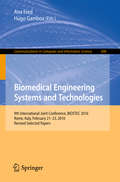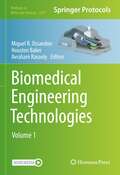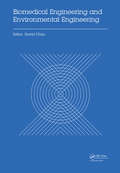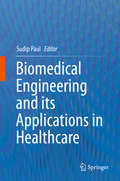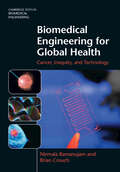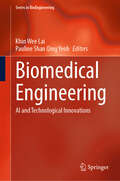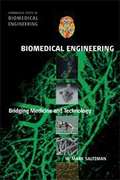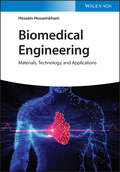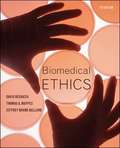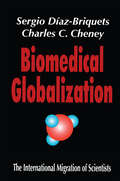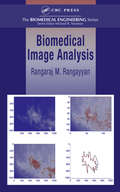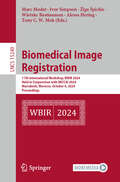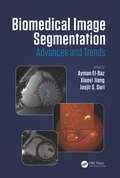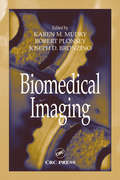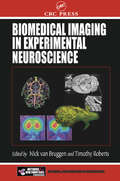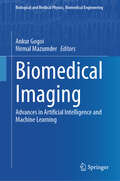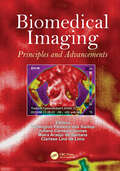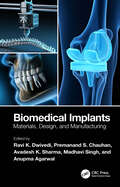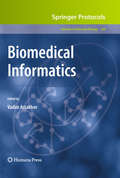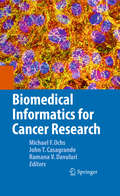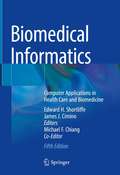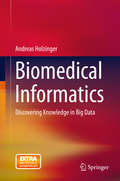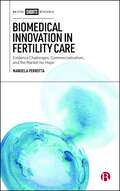- Table View
- List View
Biomedical Engineering Systems and Technologies: 9th International Joint Conference, BIOSTEC 2016, Rome, Italy, February 21–23, 2016, Revised Selected Papers (Communications in Computer and Information Science #690)
by Ana Fred Hugo GamboaThis book contains the best papers of the First International Joint Conference on B- medical Engineering Systems and Technologies (BIOSTEC 2008), organized by the Institute for Systems and Technologies of Information Control and Communication (INSTICC), technically co-sponsored by the IEEE Engineering in Medicine and Bi- ogy Society (EMB), ACM SIGART and the Workflow Management Coalition (WfMC), in cooperation with AAAI. The purpose of the International Joint Conference on Biomedical Engineering S- tems and Technologies is to bring together researchers and practitioners, including engineers, biologists, health professionals and informatics/computer scientists, int- ested in both theoretical advances and applications of information systems, artificial intelligence, signal processing, electronics and other engineering tools in knowledge areas related to biology and medicine. BIOSTEC is composed of three co-located conferences; each specializes in one of the aforementioned main knowledge areas, namely: * BIODEVICES (International Conference on Biomedical Electronics and - vices) focuses on aspects related to electronics and mechanical engineering, - pecially equipment and materials inspired from biological systems and/or - dressing biological requirements. Monitoring devices, instrumentation sensors and systems, biorobotics, micro-nanotechnologies and biomaterials are some of the technologies addressed at this conference.
Biomedical Engineering Technologies: Volume 1 (Methods in Molecular Biology #2393)
by Avraham Rasooly Houston Baker Miguel R. OssandonThis volume provides detailed technical protocols on current biosensors and imaging technologies and Chapters focus on optical, electrochemical, Quartz crystal microbalance (QCM) biosensors and on medical imaging technologies such as tomography, MRI, and NMR. Written in the format of the highly successful Methods in Molecular Biology series, each chapter includes an introduction to the topic, lists necessary materials and reagents, includes tips on troubleshooting and known pitfalls, and step-by-step, readily reproducible protocols. Authoritative and practical, Biomedical Engineering Technologies, Volume 1 provides technical details in descriptions of major technologies by experts in the field.
Biomedical Engineering Technologies: Volume 2 (Methods in Molecular Biology #2394)
by Avraham Rasooly Houston Baker Miguel R. OssandonThis volume provides detailed technical protocols on current biomedical technologies and examples of their applications and capabilities. Chapters focus on molecular and cellular analytical methods, experimental new drug delivery approaches, guided surgery, implants and tissue engineering. Written in the format of the highly successful Methods in Molecular Biology series, each chapter includes an introduction to the topic, lists necessary materials and reagents, tips on troubleshooting and known pitfalls, and step-by-step, readily reproducible protocols. Authoritative and practical, Biomedical Engineering Technologies, Volume 2 provides technical details in descriptions of major technologies by experts in the field.
Biomedical Engineering and Environmental Engineering: Proceedings of the 2014 2nd International Conference on Biomedical Engineering and Environmental Engineering (ICBEEE 2014), December 24-25, 2014, Wuhan, China
by David ChanThis conference series is a forum for enhancing mutual understanding between Biomedical Engineering and Environmental Engineering field. This proceeding provides contributions from many experts representing industry and academic establishments worldwide. The researchers are from different countries and professional. The conference brought 
Biomedical Engineering and its Applications in Healthcare
by Sudip PaulThis book illustrates the significance of biomedical engineering in modern healthcare systems. Biomedical engineering plays an important role in a range of areas, from diagnosis and analysis to treatment and recovery and has entered the public consciousness through the proliferation of implantable medical devices, such as pacemakers and artificial hips, as well as the more futuristic technologies such as stem cell engineering and 3-D printing of biological organs. Starting with an introduction to biomedical engineering, the book then discusses various tools and techniques for medical diagnostics and treatment and recent advances. It also provides comprehensive and integrated information on rehabilitation engineering, including the design of artificial body parts, and the underlying principles, and standards. It also presents a conceptual framework to clarify the relationship between ethical policies in medical practice and philosophical moral reasoning. Lastly, the book highlights a number of challenges associated with modern healthcare technologies.
Biomedical Engineering for Global Health
by Rebecca Richards-KortumCan technology and innovation transform world health? Connecting undergraduate students with global problems, Rebecca Richard-Kortum examines the interplay between biomedical technology design and the medical, regulatory, economic, social and ethical issues surrounding global health. Driven by case studies, including cancer screening, imaging technologies, implantable devices and vaccines, students learn how the complexities and variation across the globe affect the design of devices and therapies. A wealth of learning features, including classroom activities, project assignments, homework problems and weblinks within the book and online, provide a full teaching package. For visionary general science and biomedical engineering courses, this book will inspire students to engage in solving global issues that face us all.
Biomedical Engineering for Global Health: Cancer, Inequity, and Technology (Cambridge Texts in Biomedical Engineering)
by Nirmala Ramanujam Brian CrouchExplore the fundamentals of biomedical engineering technologies with this thought-provoking introduction, framed around modern-day global cancer inequities. Connecting engineering principles to real-world global health scenarios, this textbook introduces major technological advances in cancer care through the lens of global health inequity, discusses how promising new technologies can address this inequity, and demonstrates how novel medical technologies are adopted for real-world clinical use. It includes modular chapters designed to enable a flexible pathway through material, for students from a wide range of backgrounds; boxed discussion of contemporary issues in engineering for global health, encouraging students to explore ethical questions related to science and society; supplementary lab modules for hands-on experience in translating engineering principles into healthcare solutions; and over 200 end-of-chapter problems, targeting multiple learning outcomes to solidify student understanding. This introduction is designed to equip students with all the critical, technical, and ethical knowledge they need to excel.
Biomedical Engineering: AI and Technological Innovations (Series in BioEngineering)
by Khin Wee Lai Pauline Shan Qing YeohThis book brings together contributions from leading experts in the field, each addressing a critical area where AI and technology are making significant impacts. The chapters encompass a wide range of topics, from the application of machine learning in cancer grading and maternal health monitoring to the development of innovative wearable devices and advanced diagnostic tools. The book not only underscores the transformative potential of AI and technology in biomedical; but also serves as a vital resource for researchers, practitioners, and students. By showcasing the latest research and innovations, this book aims to inspire continued exploration and development in this dynamic and rapidly evolving field.
Biomedical Engineering: Bridging Medicine and Technology
by W. Mark SaltzmanThis book is an introduction to biomedical engineering, starting from the basics and demonstrating the engineering principles that are used to create new diagnostic methods and therapies for human disease. Although biomedical engineering is a relatively new field of study, it will impact almost every person in the world.
Biomedical Engineering: Materials, Technology, and Applications
by Hossein HosseinkhaniBiomedical Engineering An exploration of materials processing and engineering technology across a wide range of medical applications The field of biomedical engineering has played a vital role in the progression of medical development technology. Biomedical Engineering: Materials, Technology, and Applications covers key aspects of the field—from basic concepts to advanced level research for medical applications. The book stands as a source of inspiration for research on materials as well as their development and practical application within specialized industries. It begins with a discussion of what biomedical engineering is and concludes with a final chapter on the advancements of biomaterials technology in medicine. Offers comprehensive coverage of topics, including biomaterials, tissue engineering, bioreceptor interactions, and various medical applications Discusses applications in critical industries such as biomedical diagnosis, pharmaceutics, drug delivery, cancer detection, and more Serves as a reference for those in scientific, medical, and academic fields Biomedical Engineering takes an interdisciplinary look at how biomedical science and engineering technology are integral to developing novel approaches to major problems, such as those associated with disease diagnosis and drug delivery. By covering a full range of materials processing and technology-related subjects, it shares timely information for biotechnologists, material scientists, biophysicists, chemists, bioengineers, nanotechnologists, and medical researchers.
Biomedical Ethics (Seventh Edition)
by David Degrazia Thomas Mappes Jeffrey BallardThis best-selling anthology of readings with case studies provides insightful and comprehensive treatment of ethical issues in medicine. Appropriate for courses taught in philosophy departments, bioethics programs, as well as schools of medicine and nursing, the collection covers such provocative topics as biomedical enhancement, clinical trials in developing countries, animal research, physician-assisted suicide, and health care reform. The text's effective pedagogical features include chapter introductions, argument sketches, explanations of medical terms, headnotes, and annotated bibliographies.
Biomedical Globalization: The International Migration of Scientists
by Charles CheneyDespite much debate in recent years about the economic and professional impact of foreign engineers and computer professionals in the United States, comparatively little has been said about the growing number of foreign biomedical scientists employed by American firms and health institutions. The implications are widespread and merit serious analysis. In Biomedical Globalization, Sergio Diaz-Briquets and Charles C. Cheney shed light on this development through examination of the experience of foreign biomedical scientists at the National Institutes of Health (NIH) in Bethesda, Maryland.Diaz-Briquets and Cheney's analysis is based on results of ethnographic field observations and more than 200 interviews among diverse biomedical research constituencies in the United States and abroad. These views provide a penetrating glimpse into the complex web of interrelationships governing the international mobility of highly skilled personnel within a given scientific field. While the work of the NIH is unexceptionable in advancing biomedical knowledge and forging international research linkages, a far more complex and elusive picture emerges when the issue is placed within a broader labor market perspective. Under some circumstances the United States economy may suffer from the presence of foreign biomedical scientists in American laboratories. There is some fear that when these scientists return home they may take with them know-how developed here that could be used to strengthen the scientific prowess of overseas competitors.In conducting their research, the authors have identified several hitherto unrecognized functions that the NIH plays in channeling foreign biomedical scientists intothe American workforce. These functions are of great significance to immigration and labor policy and can be seen as instrumental to the satisfaction of numerous key public policy objectives. Biomedical Globalization will be of interest to policymakers, labor studies scholars, and scientific researchers.
Biomedical Image Analysis (Biomedical Engineering)
by Rangaraj M. RangayyanComputers have become an integral part of medical imaging systems and are used for everything from data acquisition and image generation to image display and analysis. As the scope and complexity of imaging technology steadily increase, more advanced techniques are required to solve the emerging challenges.Biomedical Image Analysis demonstr
Biomedical Image Registration: 11th International Workshop, WBIR 2024, Held in Conjunction with MICCAI 2024, Marrakesh, Morocco, October 6, 2024, Proceedings (Lecture Notes in Computer Science #15249)
by Marc Modat Ivor Simpson Žiga Špiclin Alessa Hering Wietske Bastiaansen Tony C. W. MokThis book constitutes the refereed proceedings of the 11th International Workshop on Biomedical Image Registration, WBIR 2024, held in conjunction with the 27th International conference on Medical Image Computing and Computer Assisted Intervention, MICCAI 2024, in Marrakesh, Morocco in October 2024. The 28 full papers presented in this book were carefully reviewed and selected from 32 submissions. These papers have been categorized under the following topical sections: Architectures; Robustness; Atlas/ Fusion; Feature/ Similarity Learning & Efficiency.
Biomedical Image Segmentation: Advances and Trends
by Jasjit S. Suri Xiaoyi Jiang Ayman El-BazAs one of the most important tasks in biomedical imaging, image segmentation provides the foundation for quantitative reasoning and diagnostic techniques. A large variety of different imaging techniques, each with its own physical principle and characteristics (e.g., noise modeling), often requires modality-specific algorithmic treatment. In recent years, substantial progress has been made to biomedical image segmentation. Biomedical image segmentation is characterized by several specific factors. This book presents an overview of the advanced segmentation algorithms and their applications.
Biomedical Imaging (Principles and Applications in Engineering)
by Robert Plonsey Karen M. Mudry Joseph D. BronzingComprised of chapters carefully selected from CRC‘s best-selling engineering handbooks, volumes in the Principles and Applications in Engineering series provide convenient, economical references sharply focused on particular engineering topics and subspecialties. Culled from the Biomedical Engineering Handbook, Biomedical Imaging
Biomedical Imaging in Experimental Neuroscience (Frontiers in Neuroscience)
by Bruggen Timothy RobertsWith the emergence of genetically manipulated laboratory mice as one of the most powerful tools for neuroscientists, imaging techniques capable of providing anatomical and functional information of small animals have become extremely important. Emphasizing data analysis and interpretation, Biomedical Imaging in Experimental Neuroscience presents a comprehensive review of the noninvasive biomedical imaging techniques available for laboratory animal research. It covers the scope and limitations of these methods and analyzes their impact on in vivo neuroscience research. The book also provides a concise theoretical description of the pertinent physics.
Biomedical Imaging: Advances in Artificial Intelligence and Machine Learning (Biological and Medical Physics, Biomedical Engineering)
by Ankur Gogoi Nirmal MazumderThis book presents the rapidly developing field of artificial intelligence and machine learning and its application in biomedical imaging. As is known, starting from the diagnosis of fractures by using X-rays to understanding the complex structure and function of the brain, biomedical imaging has contributed immensely toward the development of precision diagnosis and treatment strategies for numerous diseases. While continuous evolution in imaging technologies have enabled the acquisition of images having resolution and contrast far better than ever, it significantly increased the volume of data associated with each image scan—making it increasingly difficult for experts to analyze and interpret. In this context, the application of artificial intelligence (AI) and machine learning (ML) tools has become one of the most exciting frontlines of contemporary research in biomedical imaging due to their capability to extract minute traces of various disease signatures from large and complicated datasets and providing clear insight into the potential abnormalities with excellent accuracy, sensitivity, and specificity. The hallmark of this book will be the contributions from international leaders on different AI-aided advanced biomedical imaging modalities and techniques. Included will be comprehensive description of several of the technology-driven spectacular advances made over the past few years that have allowed early detection and delineation of abnormalities with sub-pixel image segmentation and classification. Starting from the fundamentals of biomedical image processing, the book presents a streamlined and focused coverage of the core principles, theoretical and experimental approaches, and state-of-the-art applications of most of the currently used biomedical imaging techniques powered by AI.
Biomedical Imaging: Principles and Advancements
by Juliana Carneiro Gomes Wellington Pinheiro dos Santos Maíra Araújo de Santana Clarisse Lins de Lima"Biomedical Imaging: Principles and Advancements" offers a captivating exploration of the intricate landscapes within the human body, revealing the transformative power of biomedical imaging. Edited by Wellington Pinheiro dos Santos, Juliana Carneiro Gomes, Maíra Araújo de Santana, and Clarisse Lins de Lima, this anthology delves into foundational concepts, from acquisition to ethical considerations, paving the way for in-depth examinations of magnetic resonance imaging, infrared thermography, and electrical impedance tomography. The real-world applications covered in Section II, from Alzheimer's diagnosis to Covid-19 assessment, showcase the diverse impact of these imaging techniques on healthcare. A collective effort, this volume inspires continued exploration in the ever-evolving field of biomedical imaging.
Biomedical Implants: Materials, Design, and Manufacturing
by Ravi K. Dwivedi, Premanand S. Chauhan, Avadesh K. Sharma, Madhavi Singh, and Anupma AgarwalThis book provides a comprehensive overview of the development of implants, from the selection of materials to the outcome of the process. It covers various steps, including biocompatible material, synthesis, and characterization, compatibility and limitations of materials, specific implants, and finite element analysis of medical implants. It also presents a comparison between predictions and experimental results by studying real-world problems and addresses the issue of sustainability in implant manufacturing, process modeling, and optimization in additive manufacturing supported by case studies. Features:• Covers the development of implants from the selection of material to the suitable process of manufacturing technologies.• Includes biocompatible material, synthesis, characterization, compatibility, and limitations of materials.• Reviews biofabrication in terms of artificial organs and soft tissues.• Discusses implant manufacturing, including additive and micro-manufacturing and failure analysis through case studies.• Addresses the issue of sustainability in implant manufacturing. This book is intended for researchers and graduate students specializing in mechanical, biomedical, healthcare engineering, biomaterials, and additive manufacturing.
Biomedical Informatics (Methods in Molecular Biology #569)
by Vadim AstakhovIn past decades, the area of bioinformatics has proved to be both dynamic and vital, producing a wide spectrum of novel approaches and assuming an increasingly important role in modern bio-technological development. In Biomedical Informatics, expert researchers explore cutting-edge new advances in the field, providing an overview of novel cyberinfrastructures which are currently under development in various bio-medical centers across the world. Chapters demonstrate various architectures for large-scale collaboration, offer modern approaches currently used in various areas of bioinformatics, and highlight the software challenges associated with large-scale biomedical informatics. Composed in the highly successful Methods in Molecular BiologyTM series format, chapters include a brief introduction, detailed methods, and a Notes section which shares tips on troubleshooting and avoiding known pitfalls. Wide-ranging and innovative, Biomedical Informatics is an essential manual for newcomers to this area, as well as an invaluable addition to the laboratories and offices of the most practiced researchers.
Biomedical Informatics for Cancer Research
by Michael F. Ochs Ramana V. Davuluri John T. CasagrandeThis book will review work from a number of researchers who have produced open source software addressing the need for data management, integration, analysis, and visualization to aid cancer research. With the advent of high-throughput technologies in biomedicine, the need for data management and appropriate data analysis tools in genomics has increased dramatically, joining clinical trials data as a major driver of informatics at cancer research centers. The gathering of this data requires careful encoding of metadata, usually through the use of controlled vocabularies or ontologies, as well as the linking of data from model organisms, done at both a physiological level (e.g., anatomy) and at a molecular level (e.g., orthology). This data will then find use within computational and statistical models, which require data pipelines and analysis systems, as well as algorithms, visualization methods, and computational modeling systems. We will introduce open source tools available for these aspects of the problem. The editors plan to divide the book into five sections, beginning with a section containing high level overviews of the field and key issues. This will include an introductory review of informatics in cancer research, followed by five overviews addressing issues in authentication and authorization, data management, data pipelines and annotations, algorithms and models, and the NCI caBIG initiative. This will be followed by sections dedicated to data systems, data pipelines, algorithms for analysis and visualization, and modeling systems. Each of these areas has seen publication of open source tools, ranging from the widely known R/Bioconductor package to little known but powerful systems such as SImmune for biochemical modeling. The area of laboratory information management systems has seen development of a number of unpublished but powerful systems, which we would also include. Three groups have agreed to provide chapters in this area (USC/Norris CAFE extensible clinical trials system, St Jude Unified LIMS, Fox Chase/British Columbia flow cytometry LIMS). While there has been a great deal of development of informatics tools that can be applied to problems in cancer research, there has not been adequate dissemination of details on these tools to the community. As such, there remains low adoption of all but a few tools. This book aims to increase overall adoption of tools by providing cancer center leaders and researchers with a single volume detailing both issues that must be addressed and tools that are ready for use.
Biomedical Informatics: Computer Applications in Health Care and Biomedicine
by Michael F. ChiangThis 5th edition of this essential textbook continues to meet the growing demand of practitioners, researchers, educators, and students for a comprehensive introduction to key topics in biomedical informatics and the underlying scientific issues that sit at the intersection of biomedical science, patient care, public health and information technology (IT). Emphasizing the conceptual basis of the field rather than technical details, it provides the tools for study required for readers to comprehend, assess, and utilize biomedical informatics and health IT. It focuses on practical examples, a guide to additional literature, chapter summaries and a comprehensive glossary with concise definitions of recurring terms for self-study or classroom use.Biomedical Informatics: Computer Applications in Health Care and Biomedicine reflects the remarkable changes in both computing and health care that continue to occur and the exploding interest in the role that IT must play in care coordination and the melding of genomics with innovations in clinical practice and treatment. New and heavily revised chapters have been introduced on human-computer interaction, mHealth, personal health informatics and precision medicine, while the structure of the other chapters has undergone extensive revisions to reflect the developments in the area. The organization and philosophy remain unchanged, focusing on the science of information and knowledge management, and the role of computers and communications in modern biomedical research, health and health care.
Biomedical Informatics: Discovering Knowledge in Big Data (Lecture Notes in Computer Science #8401)
by Andreas HolzingerThis book provides a broad overview of the topic Bioinformatics with focus on data, information and knowledge. From data acquisition and storage to visualization, ranging through privacy, regulatory and other practical and theoretical topics, the author touches several fundamental aspects of the innovative interface between Medical and Technology domains that is Biomedical Informatics. Each chapter starts by providing a useful inventory of definitions and commonly used acronyms for each topic and throughout the text, the reader finds several real-world examples, methodologies and ideas that complement the technical and theoretical background This new edition includes new sections at the end of each chapter, called "future outlook and research avenues," providing pointers to future challenges. At the beginning of each chapter a new section called "key problems", has been added, where the author discusses possible traps and unsolvable or major problems
Biomedical Innovation in Fertility Care: Evidence Challenges, Commercialization, and the Market for Hope
by Manuela PerrottaAvailable Open Access digitally under CC-BY-NC-ND licence.This book analyses the clashes between evidence-based medicine and the dynamics of an increasingly privatised fertility care industry. With a unique focus on "add-on" treatments, it reveals how these controversial treatments are now widespread and can border on hopemongering.
